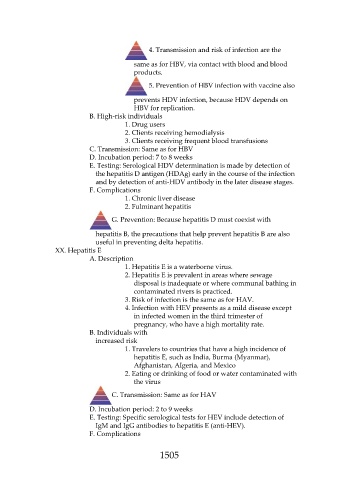Page 1505 - Saunders Comprehensive Review For NCLEX-RN
P. 1505
4. Transmission and risk of infection are the
same as for HBV, via contact with blood and blood
products.
5. Prevention of HBV infection with vaccine also
prevents HDV infection, because HDV depends on
HBV for replication.
B. High-risk individuals
1. Drug users
2. Clients receiving hemodialysis
3. Clients receiving frequent blood transfusions
C. Transmission: Same as for HBV
D. Incubation period: 7 to 8 weeks
E. Testing: Serological HDV determination is made by detection of
the hepatitis D antigen (HDAg) early in the course of the infection
and by detection of anti-HDV antibody in the later disease stages.
F. Complications
1. Chronic liver disease
2. Fulminant hepatitis
G. Prevention: Because hepatitis D must coexist with
hepatitis B, the precautions that help prevent hepatitis B are also
useful in preventing delta hepatitis.
XX. Hepatitis E
A. Description
1. Hepatitis E is a waterborne virus.
2. Hepatitis E is prevalent in areas where sewage
disposal is inadequate or where communal bathing in
contaminated rivers is practiced.
3. Risk of infection is the same as for HAV.
4. Infection with HEV presents as a mild disease except
in infected women in the third trimester of
pregnancy, who have a high mortality rate.
B. Individuals with
increased risk
1. Travelers to countries that have a high incidence of
hepatitis E, such as India, Burma (Myanmar),
Afghanistan, Algeria, and Mexico
2. Eating or drinking of food or water contaminated with
the virus
C. Transmission: Same as for HAV
D. Incubation period: 2 to 9 weeks
E. Testing: Specific serological tests for HEV include detection of
IgM and IgG antibodies to hepatitis E (anti-HEV).
F. Complications
1505

